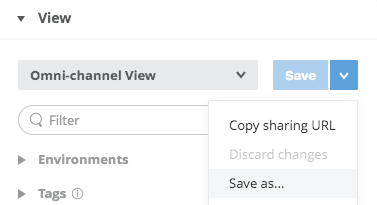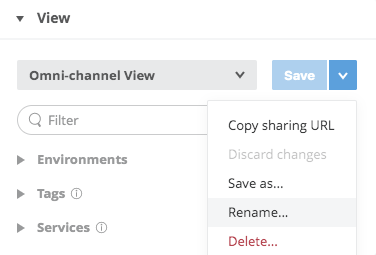
Defining a View in API Visualizer
Users with the Visualizer Editor permission can create auto-discoverable views that provide a single source of truth and are accessible to their team members across environments.
Views display your saved filter selection, including:
-
Selected environments
-
Selected tags
-
Selected nodes in the list of services
-
New services deployed that match the selected environments and tags
-
If the Show dependents and dependencies option is selected and the a service is deployed and related to a selected service
Views that you have access to appear in a list in the View card (click the drop-down arrow to see the list). This gives you easy access to all the views that are available to you, and saves you time because you don’t need to readjust filters every time you access API Visualizer to get the view that is relevant to you.
Defined Views
If you have the Visualizer Editor permission, you can create views that provide a consistent and high-quality source of truth for the architecture of each of your organization’s projects. Any API Visualizer user who has permission for the included environments can see these auto-discoverable views in a drop-down list in the View card. Only editors can create, rename, and edit defined views.
These views provide team members with a topological view of the apps that are specific to the areas they are responsible for. Providing a dynamic view for team members ensures their ability to troubleshoot their projects more quickly and easily, and promotes architectural consistency.
Create a Defined View
Only users with the Visualizer Editor permission can create defined views.
-
In the top navigation bar, on the right of the view name, click the drop-down arrow.
-
Click +New.
-
In the New view dialog, enter a Name for the view, and click Save.
-
Configure the view by selecting which environments, tags, and services to include.
-
Hide the nodes which you have selected in the canvas using the Hide selected services option.
-
Hide the services other than the nodes which you have selected using the Hide other services option.
-
Click Save.
You can also create a new view by selecting Save as from the drop-down menu to save your current filter selection updates as a new view and preserve the original view.
| When you save a view, it saves both your Production and Sandbox configurations. |
Once you save the view, it becomes accessible to other users, meaning that any user who has access to the apps in the environment sees the view in their list of views.
Edit a View
Users can make changes to their private view’s filters, and save them. However, only users with the Visualizer Editor permission can edit defined views.
-
Make the desired changes to the current filters.
An asterisk appears next to the view name until you click Save in the View card. -
Click Save.
-
(Visualizer editor only) Click Save as to save your updates as a new view and preserve the original view.

Rename a View
Users can rename their private view, but only users with Visualizer Editor permission can rename defined views.
-
Click the drop-down arrow next to Save, and click Rename.

-
In the Rename view dialog, enter a new Name, and click Save.
Share a View
Sharing a defined view is automatic in the sense that when a new view is created and saved, it is visible in the view list of users who have access to the environment and apps in the view.
You can also click Copy Sharing URL from the drop-down arrow next to Save and send it to the user with whom you want to share the view.

Delete a View
Only users with the Visualizer Editor permission can delete views.
-
Click the drop-down arrow next to Save, and select Delete.
-
Click Delete again.
Private View
When you access API Visualizer for the first time, your private view is displayed. Each subsequent time you access API Visualizer, you are returned to the view you last accessed. Your private view includes defined views, providing a complete picture of the projects to which you have access. In your private view, you can:
-
Edit and save which apps are included in your private view
-
Rename your private view
-
Discard changes you made to your private view
-
Export your private view as a PNG file
You can’t delete a private view.



